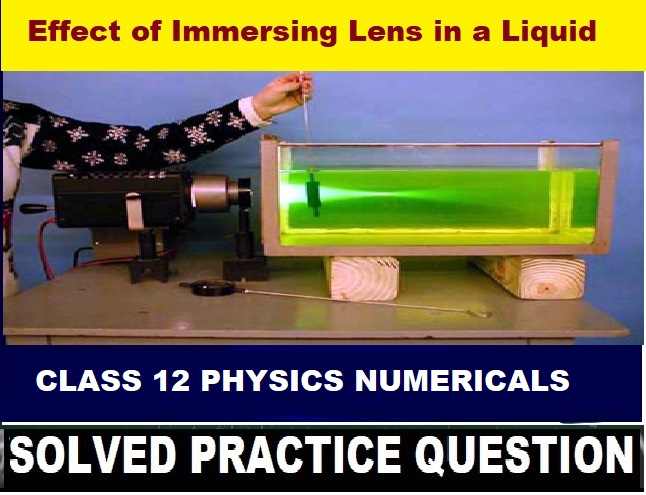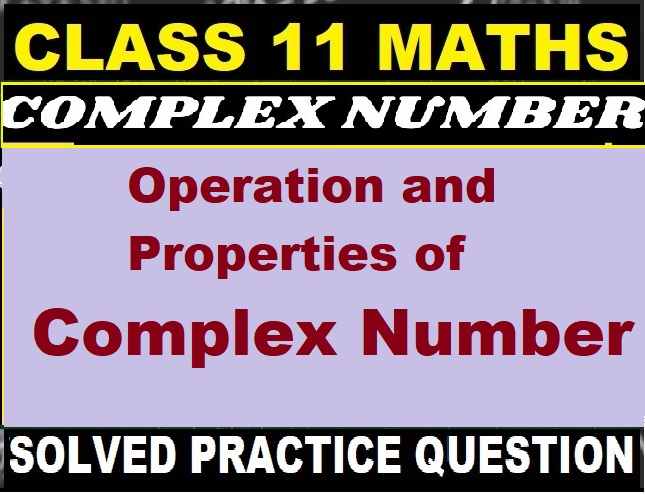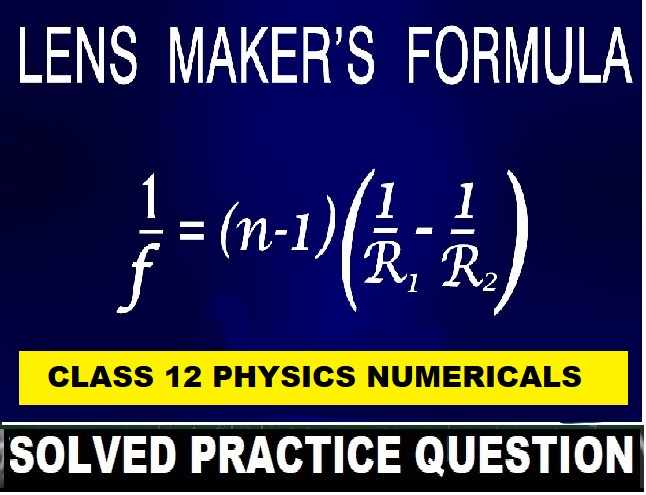ML Aggarwal Understanding Elementary Shapes Exe-11.2 Class 6 ICSE Maths Solutions. We Provide Step by Step Answer of Exe-11.2 Questions for Understanding Elementary Shapes as council prescribe guideline for upcoming board exam. Visit official Website CISCE for detail information about ICSE Board Class-6.
ML Aggarwal Understanding Elementary Shapes Exe-11.2 Class 6 ICSE Maths Solutions
| Board | ICSE |
| Publications | Avichal Publishig Company (APC) |
| Subject | Maths |
| Class | 6th |
| Chapter-11 | Understanding Elementary Shapes |
| Writer | ML Aggarwal |
| Book Name | Understanding |
| Topics | Solution of Exe-11.2 Questions |
| Edition | 2023-2024 |
Understanding Elementary Shapes Exe-11.2
ML Aggarwal Class 6 ICSE Maths Solutions
Page-235
Question 1. What fraction of a clockwise revolution does the hour hand of a clock turn through when it goes from:
(i) 4 to 10
(ii) 2 to 5
(iii) 7 to 10
(iv) 8 to 5
(v) 11 to 5
(vi) 6 to 3
Also find the number of right angles turned in each case.
Answer:
(i) 1/2, 2
(ii) 1/4, 1
(iii) 1/4, 1
(iv) 3/4, 3
(v) 1/2, 2
(vi) 3/4, 3
Question 2. Where will the hand of a clock stop if it
(i) starts at 10 and makes 1/2 of a revolution, clockwise?
(ii) starts at 4 and makes 1/4 of a revolution, clockwise?
(iii) starts at 4 and makes 3/4 of a revolution, clockwise?
Answer:
(i) at 4
(ii) at 7
(iii) at 1
Question 3. Where will the hand of a clock stop if it starts from
(i) 6 and turns through 1 right angle?
(ii) 8 and turns through 2 right angles?
(iii) 10 and turns through 3 right angles?
(iv) 7 and turns through 2 straight angles?
Answer:
(i) 9
(ii) 2
(iii) 1
(iv) 7
Question 4. What fraction of a revolution have you turned through if you stand facing
(i) north and turn clockwise to face west?
(ii) south and turn anti-clockwise to face east?
(iii) east and turn clockwise (or anti-clockwise) to face west?
Also find the number of right angles turned in each case.
Answer:
(i) 3/4, 3
(ii) 1/4, 1
(iii) 1/2, 2
Question 5. Match the following:
| (i) Straight angle | (a) More than half a revolution |
| (ii) Right angle | (b) Less than one – fourth of a revolution |
| (iii) Complete angle | (c) Half of a revolution |
| (iv) Acute angle | (d) One-fourth of a revolution |
| (v) Obtuse angle | (e) Between 1/4 and 1/2 of a revolution |
| (vi) Reflex angle | (f) One- Complete revolution |
Answer:
| (i) Straight angle | (c) Half of a revolution |
| (ii) Right angle | (d) One-fourth of a revolution |
| (iii) Complete angle | (f) One- Complete revolution |
| (iv) Acute angle | (b) Less than one – fourth of a revolution |
| (v) Obtuse angle | (e) Between 1/4 and 1/2 of a revolution |
| (vi) Reflex angle | (a) More than half a revolution |
Question 6. Classify the angles whose magnitudes are given below:
(i) 56°
(ii) 125°
(iii) 90°
(iv) 180°
(v) 215°
(vi) 328°
(vii) 89°
(viii) 178°
Answer:
(i) Acute angle
(ii) Obtuse angle
(iii) Right angle
(iv) Straight angle
(v) Reflex angle
(vi) Reflex angle
(vii) Acute angle
(viii) Obtuse angle
Understanding Elementary Shapes Exe-11.2
ML Aggarwal Class 6 ICSE Maths Solutions
Page-236
Question 7. State which of the following angles with a small letter in the following diagrams are acute, which obtuse and which are reflex:
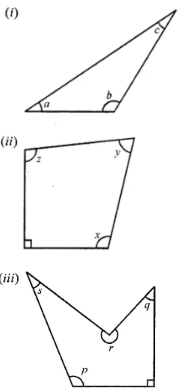
Answer:
(i) ∠a and ∠c are acute, ∠h is obtuse
(ii) ∠x and ∠z are obtuse, ∠y is acute.
(iii) ∠p is obtuse, ∠q and ∠s are acute, ∠r is reflex.
Question 8. Use your protector to measure each of the angles marked in the following figures:
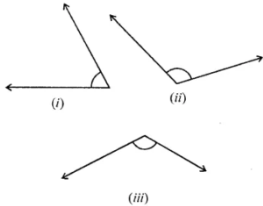
Answer:
(i) 62°
(ii) 116°
(iii) 121°
Question 9. Use your protector to measure the reflex angles marked in the following figures:
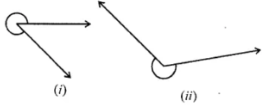
Answer:
(i) 315°
(ii) 235°
Question 10. Find the measure of the angle between the hands of the clock in each figure:
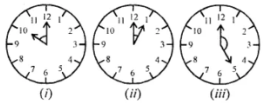
Answer:
(i) 60°
(ii) 30°
(iii) 150°
Question 11. Write the measure of the smaller angle formed by the hour and the minutes hands of a clock at 7 O’clock. Also write the measure of the other angle and also state what types of angles these are.
Answer:
Smaller angle is 150° (obtuse).
The other angle is 210° (reflex).
Question 12. There are two set-squares in your geometry box. What are measures of the angles formed at their corners? Do they have any angle measure that is common?
Answer:
One is a 30° – 60° – 90° set square; the other is 45° – 45° – 90° set square. The angle of measure 90° (i.e., a right angle) is common between them.
— : End of ML Aggarwal Understanding Elementary Shapes Exe-11.2 Class 6 ICSE Maths Solutions :–
Return to – ML Aggarwal Maths Solutions for ICSE Class -6
Thanks
